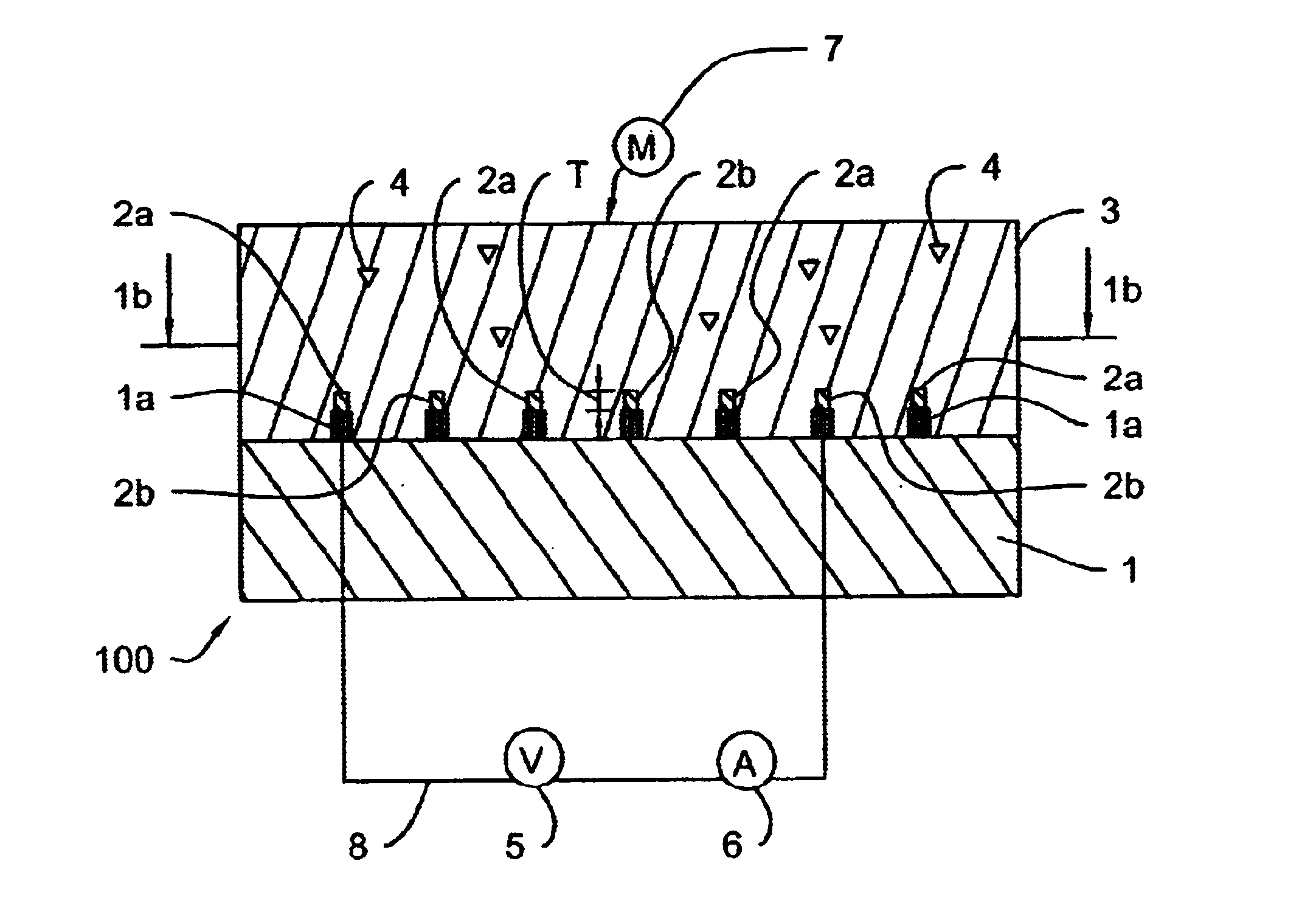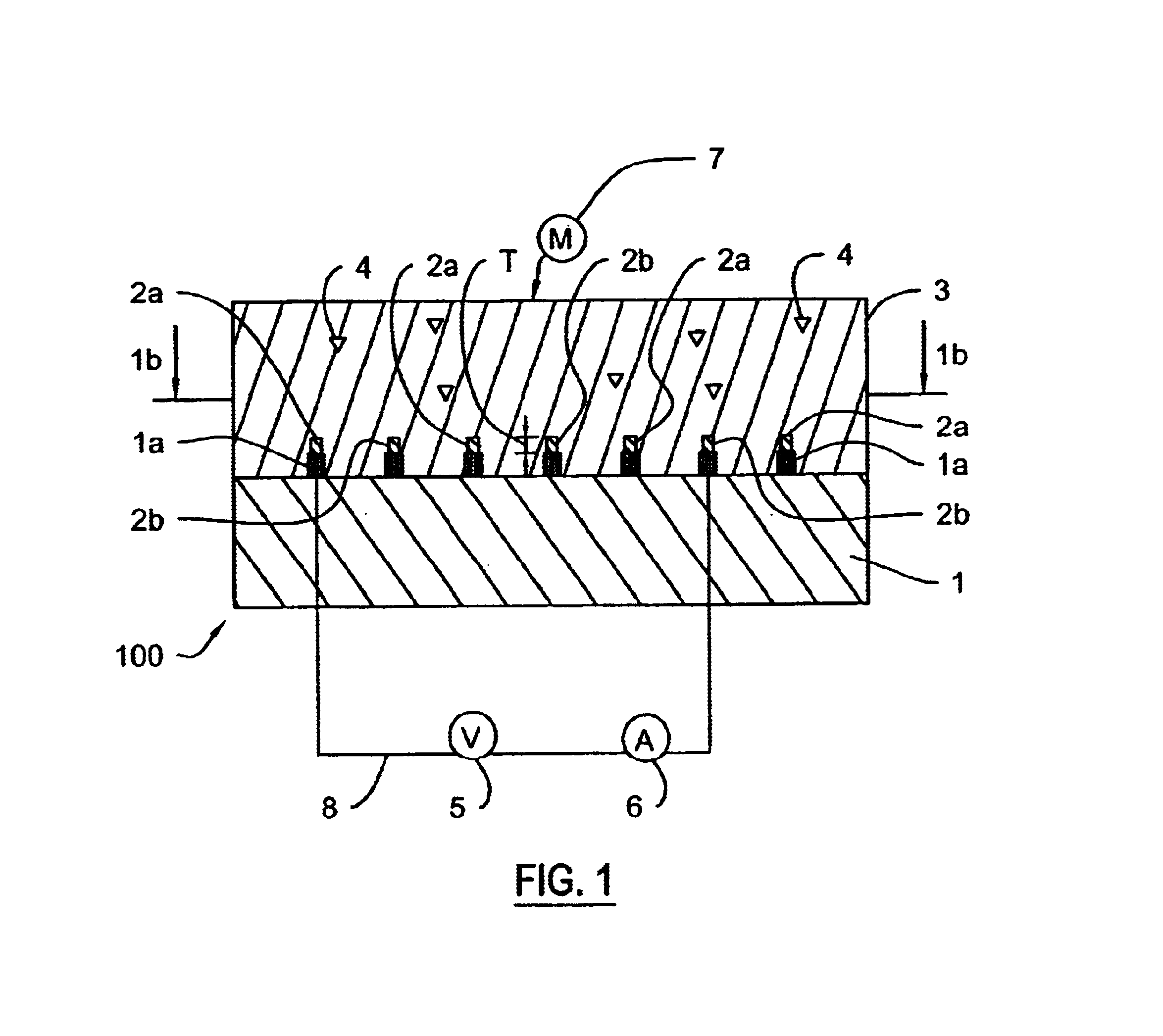Sensor for chemical and biological materials
a technology of biological pathogens and sensors, applied in the field of biological pathogen detection sensors, can solve the problems of inability to teach or disclose the measurement of response, methods of analysis and detection of inability to detect biological pathogens and chemical agents. , to achieve the effect of low false alarm rate and good selectivity
- Summary
- Abstract
- Description
- Claims
- Application Information
AI Technical Summary
Benefits of technology
Problems solved by technology
Method used
Image
Examples
example 1
on According to Method 1.
E-gel containing about 9.1.times.10.sup.-4 % of GOD, and C-gel containing between about 2.5% and about 50% by weight of conductive polymer were incorporated into another sol-gel composed of a 2:1 or a 1:1 molar mixture of TMOS and either SETMOS or GPTMS. This stock solution (a secondary siloxane) was then mixed with water and hydrochloric acid according to the following ratio:
The stock solution so treated is then used to form a 2.degree. gel, encapsulating C- and E-gels according to the following ratio:
Alternatively, the method described in Example 1, can be used with a buffer solution to enhance the viability of the immobilized enzyme. The pH 6 buffer solution is first added to the treated stock solution in the ratio of 0.55 milliliters of the buffer solution per 0.45 milliliters of the treated stock solution, and then the buffered stock solution is used to form a buffered 2.degree. gel, encapsulating C- and E-gels according to the following ratio:
example 2
on According to Method 2.
The second approach (Method 2) is similar to Method 1 except that the conductive polymer is not used as a C-gel, but instead is incorporated directly into the secondary gel. Activity testing on gel materials prepared using this second approach indicated that the pH of the gelation process is important not only for gel formation, but also for enzyme stability. Conductive polymers such as polyaniline with dodecylbenzene sulfonic acid counterion (Pani-DBSA) and a polythiophene derivative with polystyrene sulfonic acid counterion (PEDOT-PSSA) require excess counterion to provide solutions of the conductive polymers suitable for preparing a C-gel. However, this excess acid material proved to be toxic to the enzyme during the preparation of the 2.degree. gel, resulting in a significant reduction in the activity of sensors prepared from these materials. Preliminary sensor response test results with transducers so prepared demonstrated responses to glucose that were...
example 3
on According to Method 3.
Under the third approach (Method 3), the conductive polymer was encapsulated directly with the enzyme in a so-called primary gel. This approach is preferred in that the most intimate mixture of conductive polymer and enzyme will result, but is limited in scope in that only water-soluble (i.e., buffer soluble) conductive polymers are suitable. Method 3 afforded the most intimate mixing of a conductive polymer and enzyme to form a buffered primary gel, containing GOD.
A conductive polymer, in a form of a 1% to 10% aqueous solution was added to the sol, which had been previously buffered, as described in Example 2, above. An enzyme (GOD) stock solution of about 1.46 mg / ml in a pH 6 buffer was then added as follows:
For each approach, a standardized method for preparation of the various gels was developed. Gel formulations were mixed and cast onto glass slides or interdigitated electrodes 2 using the procedures similar to those described for the preparation of C-g...
PUM
| Property | Measurement | Unit |
|---|---|---|
| width | aaaaa | aaaaa |
| width | aaaaa | aaaaa |
| width | aaaaa | aaaaa |
Abstract
Description
Claims
Application Information
 Login to View More
Login to View More - R&D
- Intellectual Property
- Life Sciences
- Materials
- Tech Scout
- Unparalleled Data Quality
- Higher Quality Content
- 60% Fewer Hallucinations
Browse by: Latest US Patents, China's latest patents, Technical Efficacy Thesaurus, Application Domain, Technology Topic, Popular Technical Reports.
© 2025 PatSnap. All rights reserved.Legal|Privacy policy|Modern Slavery Act Transparency Statement|Sitemap|About US| Contact US: help@patsnap.com



